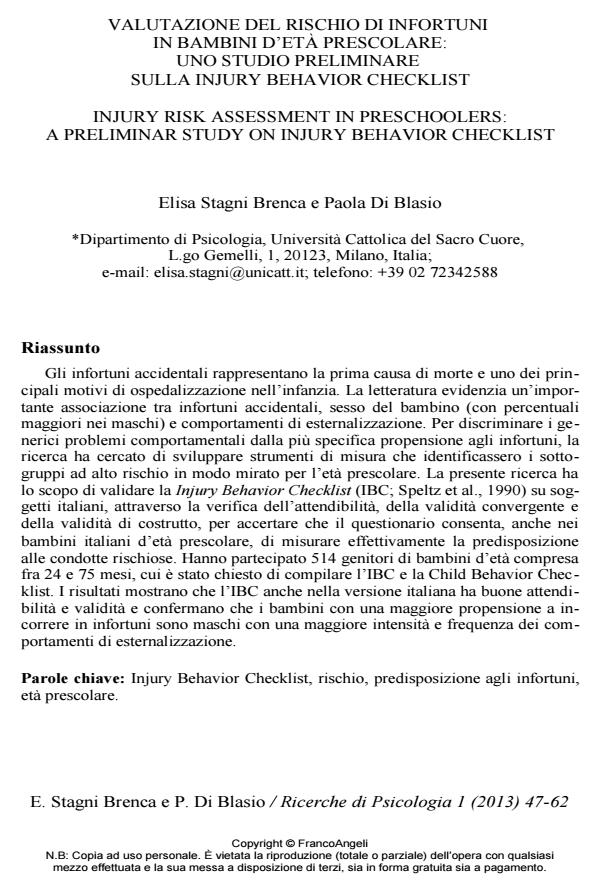Valutazione del rischio di infortuni in bambini d’età prescolare: uno studio preliminare sulla Injury Behavior Checklist
Titolo Rivista RICERCHE DI PSICOLOGIA
Autori/Curatori Elisa Stagni Brenca, Paola Di Blasio
Anno di pubblicazione 2013 Fascicolo 2013/1
Lingua Italiano Numero pagine 16 P. 47-62 Dimensione file 228 KB
DOI 10.3280/RIP2013-01002
Il DOI è il codice a barre della proprietà intellettuale: per saperne di più
clicca qui
Qui sotto puoi vedere in anteprima la prima pagina di questo articolo.
Se questo articolo ti interessa, lo puoi acquistare (e scaricare in formato pdf) seguendo le facili indicazioni per acquistare il download credit. Acquista Download Credits per scaricare questo Articolo in formato PDF

FrancoAngeli è membro della Publishers International Linking Association, Inc (PILA)associazione indipendente e non profit per facilitare (attraverso i servizi tecnologici implementati da CrossRef.org) l’accesso degli studiosi ai contenuti digitali nelle pubblicazioni professionali e scientifiche
Gli infortuni accidentali rappresentano la prima causa di morte e uno dei principali motivi di ospedalizzazione nell’infanzia. La letteratura evidenzia un’importante associazione tra infortuni accidentali, sesso del bambino (con percentuali maggiori nei maschi) e comportamenti di esternalizzazione. Per discriminare i generici problemi comportamentali dalla piu specifica propensione agli infortuni, la ricerca ha cercato di sviluppare strumenti di misura che identificassero i sottogruppi ad alto rischio in modo mirato per l’eta prescolare. La presente ricerca ha lo scopo di validare la Injury Behavior Checklist (IBC; Speltz et al., 1990) su soggetti italiani, attraverso la verifica dell’attendibilita, della validita convergente e della validita di costrutto, per accertare che il questionario consenta, anche nei bambini italiani d’eta prescolare, di misurare effettivamente la predisposizione alle condotte rischiose. Hanno partecipato 514 genitori di bambini d’eta compresa fra 24 e 75 mesi, cui e stato chiesto di compilare l’IBC e la Child Behavior Checklist. I risultati mostrano che l’IBC anche nella versione italiana ha buone attendibilita e validita e confermano che i bambini con una maggiore propensione a incorrere in infortuni sono maschi con una maggiore intensita e frequenza dei comportamenti di esternalizzazione.
Parole chiave:Injury Behavior Checklist, rischio, predisposizione agli infortuni, eta prescolare
Elisa Stagni Brenca, Paola Di Blasio, Valutazione del rischio di infortuni in bambini d’età prescolare: uno studio preliminare sulla Injury Behavior Checklist in "RICERCHE DI PSICOLOGIA " 1/2013, pp 47-62, DOI: 10.3280/RIP2013-01002